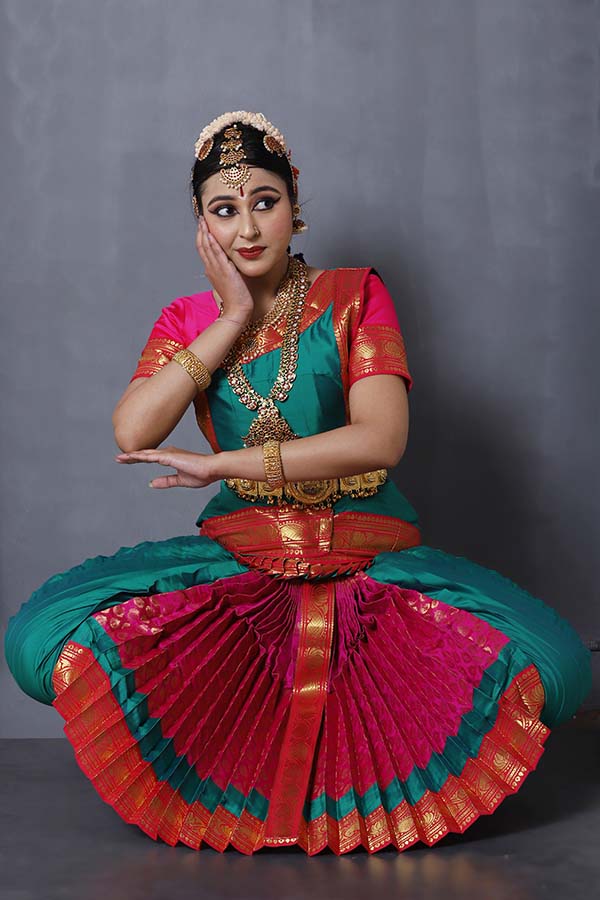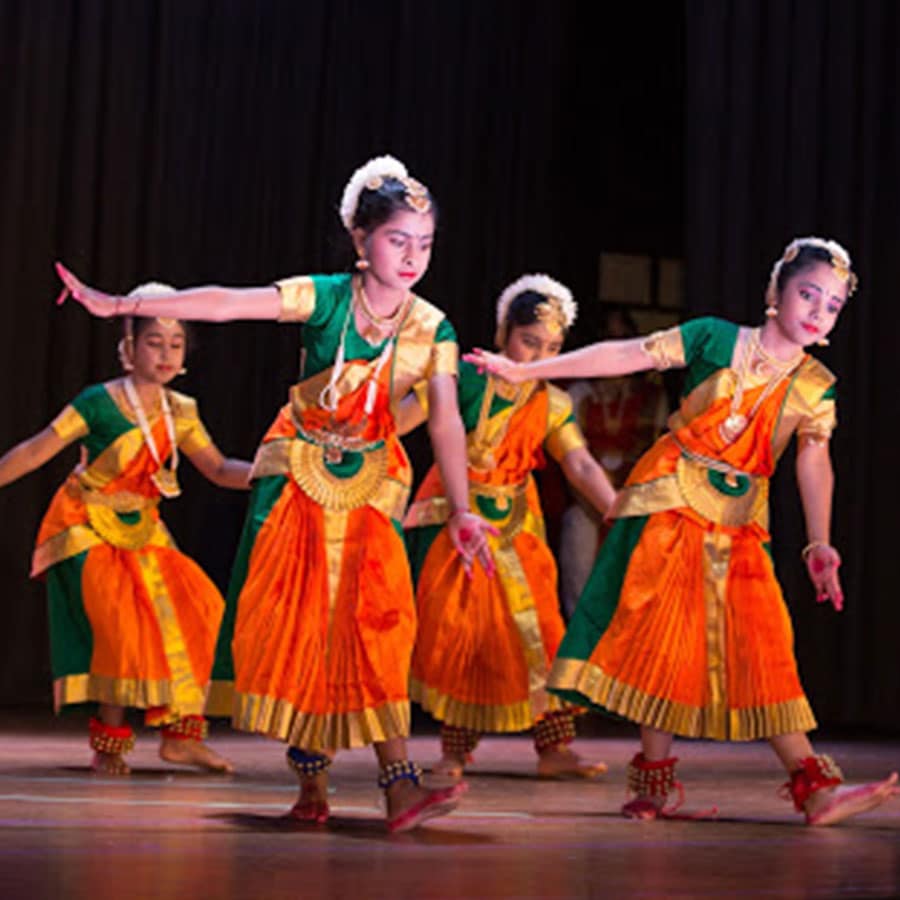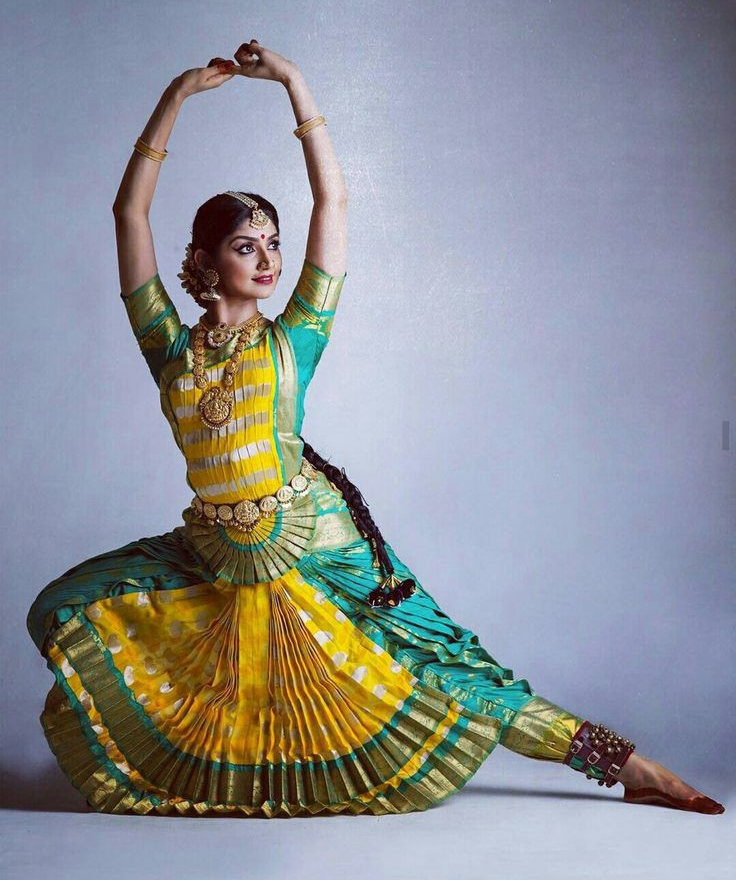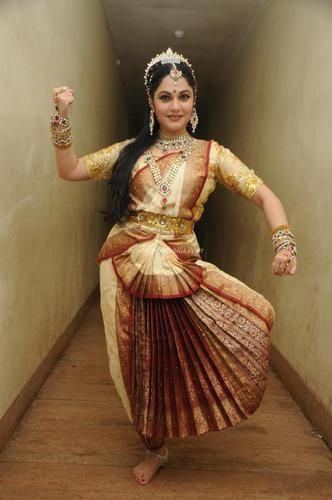Dive into the elegance of Bharatanatyam attire, exploring its rich history, varied styles, and essential accessories. Discover how this traditional ensemble accentuates the timeless charm of one of India’s most revered dance forms.
Bharatanatyam, one of the most prominent Indian classical dance forms, is a melange of expressive grace and vibrant traditions. At the heart of its visual appeal is the Bharatanatyam attire, an aspect as integral to the dance as the movements themselves.
What is the history and evolution of Bharatanatyam dresses?
Tracing its origins to the temples and courts of southern India, the Bharatanatyam costume has evolved over centuries. Originally, the temple dancers, known as Devadasis, wore traditional sarees richly woven with gold threads. As the dance form modernized, so did the costume, with the current style established in the early 20th century, designed for elegance and freedom of movement while respecting cultural modesty.
Transition and Transformation: As Bharatanatyam transitioned from the temple precincts to royal courts and eventually onto the proscenium stage, the attire too underwent significant changes. The pivotal transformation era was during the British colonial rule, particularly the 19th and early 20th centuries. The socio-political turmoil led to the decline of various cultural practices, including traditional dance forms.
It was in the early 20th century, amid a broader cultural resurgence, that a renaissance of Bharatanatyam occurred. Visionaries like Rukmini Devi Arundale played an instrumental role in reviving the dance, and with it, reimagining the traditional attire. The objective was to preserve the costume’s cultural and religious essence while ensuring practicality for stage performances.
Modern-Day Costume: The contemporary Bharatanatyam dress, established during this revival, was designed for elegance and comfort.

What are the different styles of Bharatanatyam costumes?
Bharatanatyam costumes embrace several styles, primarily the ‘Pyajama’ style and the ‘Saree’ style. The former is a tailor-fitted, two-piece costume while the latter is a specially stitched outfit that gives the illusion of a saree but is much more manageable during complex dance maneuvers.
- The Pyjama or Pant Style Costume:
- This style is widely used due to its ease of wear and comfort during dance movements.
- It consists of a pair of brightly colored satin pants worn with a matching, long-sleeved, tight-fitting blouse (choli).
- Over the pants, dancers wear a stitched, pleated piece of cloth that opens like a fan when they spread their legs for various dance postures. This pleated cloth, known as the “fan,” helps accentuate the dance movements.
- The waist is further adorned with a belt (vanki), usually embellished with traditional motifs, which helps hold the pleated cloth in place and highlights the dancer’s waist movements.
- The Saree Style Costume:
- Deriving from the traditional South Indian saree, this style is a pre-stitched adaptation designed to stay intact through rigorous dance movements.
- The costume imitates the elegance and flow of a saree but is usually a one-piece attire. It includes a choli, and the rest of the costume is cleverly draped to resemble the saree’s folds and pleats.
- Like the pajama style, it also features the characteristic pleated cloth at the front, which fans out during the dance.
- This style, although offering the saree’s grace, eliminates the complications involved in draping and allows the dancer more comfort and freedom of movement.
How to choose the right Bharatanatyam dress for a performance?
Selecting the perfect ensemble involves considerations of comfort, fit, fabric, and personal preference in color and design. Authentic silk costumes with intricate zari work capture the traditional essence, but lighter, more breathable materials are often preferred for longer performances.
What are the essential accessories for a Bharatanatyam costume?
A dancer’s attire is incomplete without traditional temple jewelry. This includes an array of ornaments like the headpiece, earrings, necklaces, bangles, waist belts, and anklets. Makeup and hairstyles, such as the classical bun adorned with flowers, accentuate the dancer’s expressions.
How to drape a Bharatanatyam saree?
The art of draping a Bharatanatyam saree, or the ‘Kacham’ style, involves tucking and pleating the specially stitched saree to allow for unrestricted movement while maintaining the aesthetic semblance of the traditional saree. It is a skill often passed down through generations and learned through meticulous practice.

What are the traditional colors for Bharatanatyam dresses?
Colors play a symbolic role, with red representing Shakti (energy) and white purity. However, dancers today experiment with a spectrum of colors, though bright, vivid hues remain a staple to portray the dance’s vibrancy.
- Red: Perhaps the most popular color for Bharatanatyam costumes, red symbolizes passion, energy, and auspiciousness. It’s often associated with life, vitality, and celebration. In many Indian traditions, red is a color of purity, which is why it’s so prevalent in wedding sarees and other ceremonial attires.
- Yellow (or Saffron): Yellow represents sanctity and religious abstinence. Specifically, saffron, a shade of yellow, symbolizes fire and the burning away of impurities, leading to purity of mind, spirit, and body. It’s a common color worn by sages and ascetics in India.
- Green: Green is a symbol of nature, fertility, and life. It relates to the heart chakra, which is considered the center of the chakra system in yogic traditions. In Bharatanatyam, a green costume can be used to symbolize the creation and celebration of life or the beauty of nature.
- Blue: Blue is often associated with the divine, given its link to the sky and the ocean. It represents calmness, stability, and tranquility. In Hindu mythology, many deities are depicted with blue skin, representing their infinite and immeasurable nature.
- White: White is a representation of purity, peace, and knowledge. It’s often seen in religious events and settings. In the context of Bharatanatyam, white can symbolize clarity, purity of emotion, and divine light.
- Black: While not as common traditionally due to its association with darkness and the unknown, black, when used, represents power, elegance, and formality. It can sometimes symbolize the destruction of ignorance, and in some compositions, it may be used for its high visual contrast.
Can I rent a Bharatanatyam costume for a dance performance?
Yes, renting a costume is a practical option for those not regularly performing. Several online platforms and dance academies offer rental services, providing a wide range of sizes, designs, and accessories.

What is the significance of jewelry in Bharatanatyam attire?
Jewelry in Bharatanatyam is steeped in symbolism, with each piece traditionally representing a different aspect of the divine. The headpiece, or ‘Nethichutti,’ symbolizes the third eye of knowledge, while the ‘Aranjanam’ (waist belt) represents control over passion, thereby maintaining the spiritual motif underlying the dance form.
Are there specific guidelines for dressing in Bharatanatyam for beginners?
Beginners are encouraged to focus on comfort and functionality. Investing in a well-fitted, standard costume and a basic set of jewelry allows novice dancers to become accustomed to the attire without being overwhelmed by its intricacies.
How to maintain and care for a Bharatanatyam costume?
Proper maintenance involves gentle hand-washing and air-drying the costumes, while jewelry requires regular cleaning to prevent tarnishing. Proper storage in cool, dry spaces preserves the fabric and embroidery, ensuring the ensemble’s longevity.
What materials are commonly used to make Bharatanatyam costumes?
Authentic Bharatanatyam dresses are traditionally crafted from pure silk, known for its lustrous beauty and durability. However, costumes made from art silk, cotton-silk blends, and other synthetic materials have gained popularity for their affordability and ease of maintenance.
- Silk: Traditionally, pure silk is the most sought-after fabric for Bharatanatyam costumes. Its natural sheen, texture, and strength make it ideal for vigorous movements in dance. Silk costumes are often richly hued and adorned with gold borders and motifs, adding to the grandeur of the performance. Kanchipuram silk from South India is especially famous for its quality and craftsmanship.
- Art Silk (Artificial Silk): As pure silk can be quite expensive, art silk or synthetic silk fabrics are commonly used as a cost-effective alternative. While art silk may not offer the same luster and richness as pure silk, advances in textile technology have enabled it to provide a similar look and feel, making it a popular choice among dancers.
- Cotton Silk: A blend of cotton and silk, this fabric combines the comfort and breathability of cotton with the subtle sheen of silk. It’s lighter than pure silk and easier to manage, making it another suitable material for dancers, particularly in hot and humid climates.

